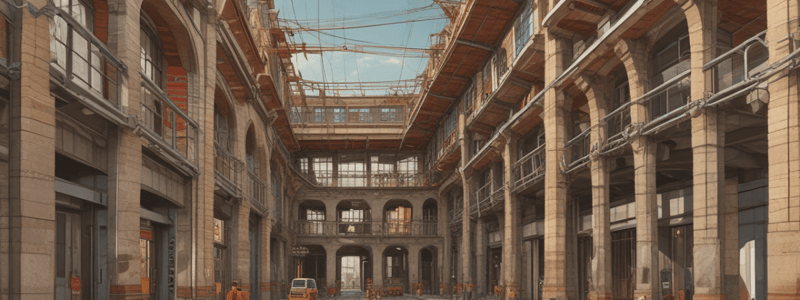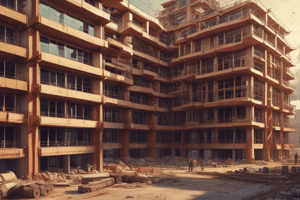Podcast
Questions and Answers
What is the primary purpose of using lightweight aggregates in manufacturing?
What is the primary purpose of using lightweight aggregates in manufacturing?
- To reduce the weight of the final product
- To improve the durability of the final product
- To increase sound resistance
- To increase thermal and fire resistance (correct)
What is the primary function of the weigh batcher in the manufacturing process?
What is the primary function of the weigh batcher in the manufacturing process?
- To measure the proper amounts of each material (correct)
- To compact the blocks
- To mix the dry materials
- To add water to the mixture
What is the purpose of the conveyor belt in the manufacturing process?
What is the purpose of the conveyor belt in the manufacturing process?
- To compact the blocks
- To store the sand and gravel outside in piles
- To transfer the sand and gravel into storage bins in the plant (correct)
- To transfer the mixed concrete to the molds
What type of kiln is commonly used in the curing process?
What type of kiln is commonly used in the curing process?
What is added to the mixer after the dry materials are blended?
What is added to the mixer after the dry materials are blended?
What is the purpose of the rotating brush in the molding process?
What is the purpose of the rotating brush in the molding process?
What is the primary function of the molds in the manufacturing process?
What is the primary function of the molds in the manufacturing process?
How long are the blocks held in the kiln at room temperature?
How long are the blocks held in the kiln at room temperature?
What is the controlled rate of temperature increase when introducing steam to concrete blocks?
What is the controlled rate of temperature increase when introducing steam to concrete blocks?
What is the purpose of the automatic stacker or loader in the curing process?
What is the purpose of the automatic stacker or loader in the curing process?
What is the typical range of dry density for concrete blocks?
What is the typical range of dry density for concrete blocks?
What is the main factor that determines the compressive strength of concrete blocks?
What is the main factor that determines the compressive strength of concrete blocks?
What is the purpose of specifying the nominal dimensions of concrete masonry units?
What is the purpose of specifying the nominal dimensions of concrete masonry units?
What is the classification of concrete masonry units based on their load-bearing capacity?
What is the classification of concrete masonry units based on their load-bearing capacity?
What is the effect of increasing the density of concrete blocks on their strength?
What is the effect of increasing the density of concrete blocks on their strength?
What is the typical range of actual dimensions for a 200200400 mm concrete block?
What is the typical range of actual dimensions for a 200200400 mm concrete block?
What are the three basic forms of concrete blocks?
What are the three basic forms of concrete blocks?
What is the primary factor that influences the properties of concrete blocks?
What is the primary factor that influences the properties of concrete blocks?
What is the primary use of concrete blocks in construction?
What is the primary use of concrete blocks in construction?
What is the term referred to as the process of forming and hardening concrete blocks before they are brought to the job site?
What is the term referred to as the process of forming and hardening concrete blocks before they are brought to the job site?
Who designed the first hollow concrete block in 1890?
Who designed the first hollow concrete block in 1890?
What is the approximate weight of a concrete block patented by Harmon S. Palmer in 1900?
What is the approximate weight of a concrete block patented by Harmon S. Palmer in 1900?
What is the approximate number of companies manufacturing concrete blocks in the United States by 1905?
What is the approximate number of companies manufacturing concrete blocks in the United States by 1905?
What is the main component of concrete used to make concrete blocks?
What is the main component of concrete used to make concrete blocks?
What is the classification of concrete masonry units based on their density?
What is the classification of concrete masonry units based on their density?
What is the characteristic of the surface texture of concrete blocks?
What is the characteristic of the surface texture of concrete blocks?
What is the color of the concrete blocks produced?
What is the color of the concrete blocks produced?
What is the primary cause of efflorescence in concrete blocks?
What is the primary cause of efflorescence in concrete blocks?
What is the general fire-resistance of concrete blocks?
What is the general fire-resistance of concrete blocks?
What is the main factor that affects the thermal conductivity of a concrete block?
What is the main factor that affects the thermal conductivity of a concrete block?
What is the effect of moisture content on the thermal conductivity of a concrete block?
What is the effect of moisture content on the thermal conductivity of a concrete block?
What type of concrete blocks have relatively low thermal conductivities?
What type of concrete blocks have relatively low thermal conductivities?
How long can a 100 mm thick concrete block provide adequate resistance to fire if load-bearing?
How long can a 100 mm thick concrete block provide adequate resistance to fire if load-bearing?
What is the effect of increasing moisture content on efflorescence in concrete blocks?
What is the effect of increasing moisture content on efflorescence in concrete blocks?
Why do cellular and hollow blocks have lower thermal conductivities than their solid counterparts?
Why do cellular and hollow blocks have lower thermal conductivities than their solid counterparts?
What should be obtained from the manufacturer to determine the fire-resistance of a concrete block?
What should be obtained from the manufacturer to determine the fire-resistance of a concrete block?
What is the primary purpose of determining the water absorption of concrete masonry units?
What is the primary purpose of determining the water absorption of concrete masonry units?
What is the method used to determine the compressive strength of individual concrete masonry units?
What is the method used to determine the compressive strength of individual concrete masonry units?
What is the main factor that influences the magnitude of dimensional changes in concrete blocks?
What is the main factor that influences the magnitude of dimensional changes in concrete blocks?
What is the most important type of shrinkage in normal applications of concrete blocks?
What is the most important type of shrinkage in normal applications of concrete blocks?
How can drying shrinkage of concrete blocks be reduced significantly?
How can drying shrinkage of concrete blocks be reduced significantly?
What type of blocks are more susceptible to frost attack?
What type of blocks are more susceptible to frost attack?
What is the general rule for selecting concrete blocks for extreme conditions of pollution and weather?
What is the general rule for selecting concrete blocks for extreme conditions of pollution and weather?
What is the purpose of the ASTM C140 standard?
What is the purpose of the ASTM C140 standard?
What is the standard used to determine the amount of water absorption of concrete masonry units?
What is the standard used to determine the amount of water absorption of concrete masonry units?
Flashcards are hidden until you start studying
Study Notes
Blocks
- A concrete block is a building material used in wall construction, also known as a concrete masonry unit.
- The first hollow concrete block was designed by Harmon S. Palmer in the United States in 1890.
- By 1905, around 1,500 companies were manufacturing concrete blocks in the United States.
Raw Materials
- Concrete blocks are made from a mixture of powdered portland cement, water, sand, and gravel.
- The mixture produces a light gray block with a fine surface texture and high compressive strength.
- Concrete masonry units are manufactured in three classes: lightweight, medium-weight, and normal-weight units, based on their density.
Manufacturing Process
- The process involves mixing, molding, and curing.
- Mixing involves blending dry materials (sand, gravel, and cement) with water and admixture chemicals.
- Molding involves compacting the mixed concrete into blocks, which are then pushed out of molds onto a flat steel pallet.
- Curing involves conveying the blocks to an automated stacker or loader, which places them in a curing rack.
Form and Size
- There are three basic forms of concrete blocks: solid, cellular, and hollow.
- Concrete masonry units are specified by their nominal dimensions, which are greater than their actual dimensions by the thickness of the mortar joint.
- Different types of concrete blocks include solid, cellular, hollow, common, facing, normal, insulating, lintel, quoin, cavity closure, and multipurpose blocks.
Properties
- The properties of concrete blocks depend on the type and proportions of constituent materials, manufacturing process, mode and duration of curing, and form and size of the block.
- Density ranges from 500-2100 kg/m3, depending on aggregate density, size, and grading, degree of compaction, and block form.
- Compressive strength is the basic requirement of concrete blocks, and is dependent on mix composition, degree of compaction, and aggregate type.
- Water absorption is controlled by ASTM standards to reduce weathering effects and limit shrinkage due to moisture loss.
- Dimensional changes occur due to variations in ambient moisture and temperature conditions, influenced by constituent materials, mix proportions, and manufacturing process.
- Durability is generally adequate for most normal applications, but may be affected by extreme conditions of pollution and weather.
- Efflorescence is rarely a problem with concrete blocks, but may occur as a result of a reaction between free hydroxides and atmospheric carbon dioxide.
- Fire resistance is good, with most concrete blocks providing adequate resistance to fire for up to 2 hours if load-bearing or up to 4 hours if non-load-bearing.
- Thermal conductivity is largely dependent on block density, with autoclaved aerated concrete and lightweight concrete blocks having relatively low thermal conductivities.
Studying That Suits You
Use AI to generate personalized quizzes and flashcards to suit your learning preferences.




